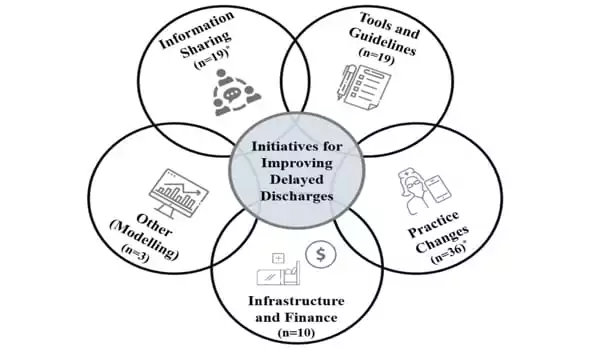New research could significantly reduce overcrowding in emergency rooms, resulting in significant financial savings. Experts have created a prediction model to identify patients who are at high risk of occupying hospital beds for longer than necessary. Experts from the University Hospitals of North Midlands NHS Trust and Staffordshire University collaborated to develop a prediction model to identify patients who are at risk of occupying hospital beds for longer than necessary.
A new study funded by the North Staffordshire Medical Institute (NSMI) describes an eight-variable predictive tool that can calculate the likelihood of a patient being discharged late at the time of admission.
Delayed discharge from hospital is one of the most serious problems confronting the NHS, and it has grown significantly in the last decade. Delay in bed days costs the equivalent of £27,000 per hour, according to 2019 data, and the additional pressures of COVID-19 have since exacerbated the problem.
“A delayed transfer of care occurs when an adult inpatient is medically ready to go home but is unable to do so because other necessary care, support, or accommodation is unavailable,” Dr. Andrew Davy, GP Lead for Research and Development in A&E at UHNM, explained. These delays can have serious consequences, including mortality, infections, depression, and reductions in patients’ mobility and ability to carry out daily activities.
Based on the findings of this study, the researchers hope to improve the accuracy of the risk calculator and collaborate with local governments to better understand the logistics of patient aftercare.
Dr. Keira Watts and Dr. Simon Lea
“It also has repercussions for patients in A&E departments who are unable to move into ward beds until current patients are discharged. This bottleneck effect on flow results in significant overcrowding within emergency departments and other emergency portals, resulting in increased mortality, poor patient outcomes, and significantly higher hospital resource consumption.”
Md Asaduzzaman, Associate Professor in Operational Research at Staffordshire University, explained how the predictive tool was created: “Administration and clinical data from the Royal Stoke University Hospital’s emergency department were analyzed for the study, which spanned a three-year period from 2018 to 2020.” The researchers used data routinely collected when patients are admitted to hospital from A&E to identify several demographic, socioeconomic, and clinical factors associated with whether or not patients experienced a delayed transfer of care.

“Age, gender, ethnicity, national early warning score (NEWS), Glasgow admission prediction score, Index of Multiple Deprivation decile, ambulance arrival, and previous admission within the previous year all had a statistically significant association with delayed transfers of care.”
The prediction model and digital toolkit are currently being tested at Royal Stoke University Hospital with Thomas Hill, Technical Business Intelligence Analyst/Developer at UHNM, who is developing how the scoring system is visually displayed on A&E’s live dashboards to ensure patients at high risk of delayed transfers of care are flagged early to reviewing teams. Additional variables that are thought to be causal in delayed discharge are currently being reviewed. The researchers believe that this predictive model could be easily implemented across the country in the future.
“Better discharge planning would reduce a huge cost burden to the NHS, and we believe that this paper could have a major impact on managing patients,” said Sarahjane Jones, Associate Professor of Patient Safety.
“Knowing who is statistically more likely to have a delayed discharge could help hospitals target patients for proactive discharge planning early in their care journey. This could be accomplished by notifying internal teams such as therapists and external partners earlier, allowing for more timely provision of community care plans and placements in residential and nursing homes.”
Based on the findings of this study, the researchers hope to improve the accuracy of the risk calculator and collaborate with local governments to better understand the logistics of patient aftercare. Dr. Keira Watts and Dr. Simon Lea of UHNM Research and Innovation, who were involved in the project’s development, are eager to see this work continue.
Dr. Lea stated: “This work is critical for the well-being of our patients and the delivery of our services, and we are delighted that it is supported by a North Staffordshire Medical Institute grant and has the potential to have such a large impact. We look forward to future grant applications and research projects with Dr. Davy and Prof. Asaduzzaman.”
Asaduzzaman, Associate Professor, added: “Our model is based on data that is routinely collected in all hospitals, so it has the potential to be adopted across the NHS. This issue is not going away, and in the aftermath of COVID-19, it is more important than ever to find solutions. We must create a well-designed patient care pathway model for vulnerable patients that includes all stakeholders, such as acute care hospitals and social care centers, as well as local governments.”














